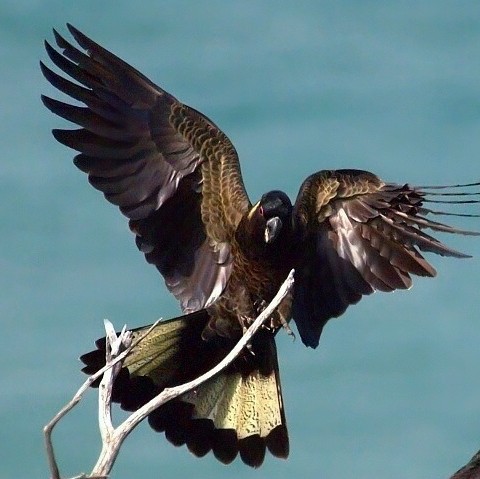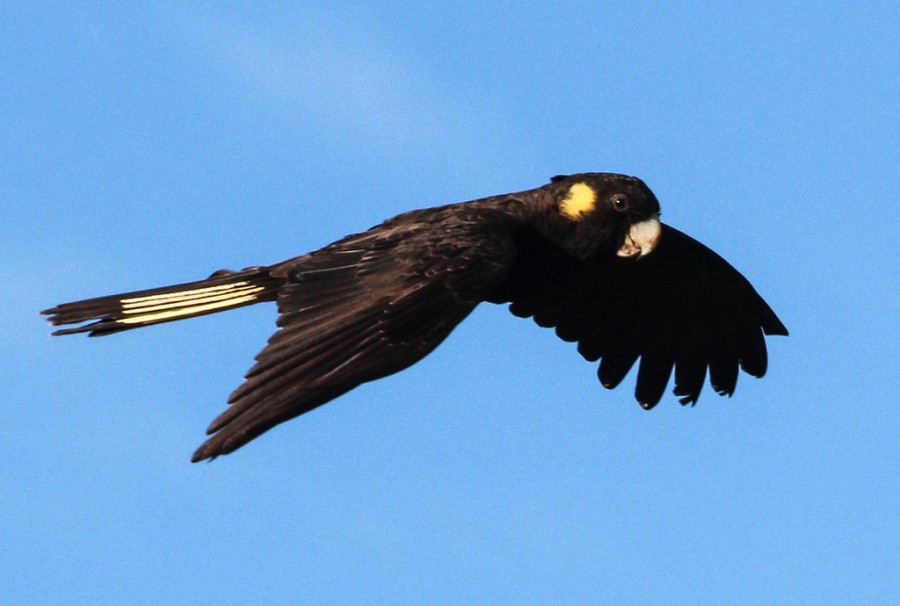In December at Sea Zen we keep our ears open for the sound of migrating Yellow Tailed Black Cockatoos, our favourite visiting birds. It’s an eerie high pitched wailing ‘Skeow Skeow Skeow’ sound that can penetrate a kilometre before we see them.
Then all of a sudden three of them will fly past and up the Separation Creek valley, off in search of their favourite Pine trees. You might see them at Sea Zen too – you never know your luck!

A family of three Cockatoos appear from nowhere
A few hours later they will lope back down the valley and land in our Banksia tree at Sea Zen and start ripping the cones apart. Hear the eerie bird call here.
They will come and go along the cool Otway coast for the next few months.

Yellow Tailed Black Cockatoo in a pine tree
The Yellow Tailed Black Cockatoo
At 63cm long Zanda Funerea are one of the biggest Cockatoos, with a bright yellow tail, yellow cheeks and a black crest.

Distinctive Yellow Tail
Their huge curved beak is perfect for slicing and ripping through tree branches to find their favourite grubs under the bark. They slice through 3cm branches effortlessly.

YTBC eating Pine cone
They naturally feed on a banksia cone in their claws and slice the seeds open, but their favourite seeds are the common Pine cone. They can spend 20 minutes systematically pulling it apart to get at the oily seeds inside.
Bouncy Flight
Yellow Tails have the most amazing flight, with deep and slow wingbeats, they cruise along effortlessly but fast, bouncing up a little as their wings beat down.
Several times we have followed a group of three birds along the Great Ocean Road at 60 km/hr and they teased us just metres away on the ocean side. The shared trip was about 5 km and they bounced along on their slow wingbeats, often swapping places in the joy of their easy flight. We felt so blessed to share the space with them.

YTBC in flight
Breeding
They naturally nest in a very large hollow log. The female alone incubates the eggs, while the male supplies her with food. Both parents help to raise the chicks, although usually only one chick survives. Chicks fledge from the nest three months after hatching and remain in the company of their parents until the next breeding season. This is the reason they are often found in threes, like our seasonal visitors.
Numbers are reportedy dropping, probably due to reduction in the number of suitable nesting trees as the older forests are logged. A typical hollow nesting tree is over 200 years old, not so many of them these days.
Like other cockatoos, they are long-lived, reaching 40 years in captivity.
Ripping

Grubbing
See them in action ripping trees apart to find grubs, and more – on this fabulous website by Internet Bird Collection, also nice images and recordings of their calls.

Places where videos and images taken on IBC
Cruising
They are found all along the south east Australian coast, very common around pine plantations for obvious reasons, where they can flock in the hundreds.

Flock in flight
There are few live videos of them in cruise mode, as they move so fast and they go where they please.
Maybe you’ll be lucky to see a mob cruising along the Great Ocean Road when you visit Sea Zen – you never know!
